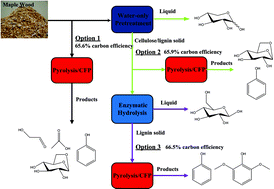Depolymerization of lignocellulosic biomass to fuel precursors: maximizing carbon efficiency by combining hydrolysis with pyrolysis
Abstract
In this paper we study the

- This article is part of the themed collection: Fuels of the future
* Corresponding authors
a
Department of Chemical Engineering, University of Massachusetts, 159 Goessmann Laboratory, Amherst, MA 01003, USA
E-mail:
huber@ecs.umass.edu
Tel: +4135450276
b Center for Environmental Research and Technology (CE-CERT), Chemical and Environmental Engineering Department, Bourns College of Engineering, University of California, Riverside, CA 92507, USA
c Center for Bioproducts and Bioenergy, Washington State University, Richland, WA 99354, USA
In this paper we study the

 Please wait while we load your content...
Something went wrong. Try again?
Please wait while we load your content...
Something went wrong. Try again?
J. Jae, G. A. Tompsett, Y. Lin, T. R. Carlson, J. Shen, T. Zhang, B. Yang, C. E. Wyman, W. C. Conner and G. W. Huber, Energy Environ. Sci., 2010, 3, 358 DOI: 10.1039/B924621P
To request permission to reproduce material from this article, please go to the Copyright Clearance Center request page.
If you are an author contributing to an RSC publication, you do not need to request permission provided correct acknowledgement is given.
If you are the author of this article, you do not need to request permission to reproduce figures and diagrams provided correct acknowledgement is given. If you want to reproduce the whole article in a third-party publication (excluding your thesis/dissertation for which permission is not required) please go to the Copyright Clearance Center request page.
Read more about how to correctly acknowledge RSC content.
 Fetching data from CrossRef.
Fetching data from CrossRef.
This may take some time to load.
Loading related content
